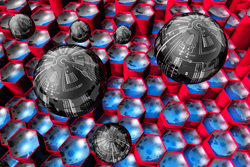A tiny world of possibilities
Beyond what the eye can see there is a minute world that can be manipulated for use in many ultra-modern applications, from integrated technology to medical diagnostics. The EU-funded project 'Bio-Inspired Self-assembled Nano-Enabled Surfaces' (Bisnes) is working on advanced nanofabrication techniques to create nanostructured surfaces ranging from the sub-molecular level to the supra-molecular level. These high-resolution nanosurfaces measure between tens of nanometres (nm) to around 100 nm, i.e. similar to biomolecular surfaces (living tissue), enabling them to interact with biomolecules. Bisnes is also creating hybrid bio-non-bio nanostructures that can preserve or amplify the biological functions of embedded biomolecules, holding much promise for medical applications. To achieve its objectives, Bisnes is developing computer algorithms and software that are capable of representing and quantifying biomolecular surfaces. This knowledge will enable the design, fabrication and implementation of highly advanced hybrid bio-devices that are more sensitive and more efficient, time-wise and cost-wise. The project team is composed of several small and medium-sized enterprises (SMEs) that are interested in creating spin-off companies with this new, promising technology. This holds particularly true in light of the expected impact on a large range of products and applications, including drug discovery devices and ultra-sensitive bio-diagnostics. The latter represent devices that are important in studying critical diseases such as neurodegenerative illnesses and cancer. The technology may also be used to develop smart bactericidal surfaces and medical devices for the in vitro study of specific proteins. Last but not least, other promising applications include hybrid nanodevices with new electromagnetic properties to help power information technology (IT) devices in the future more efficiently.







